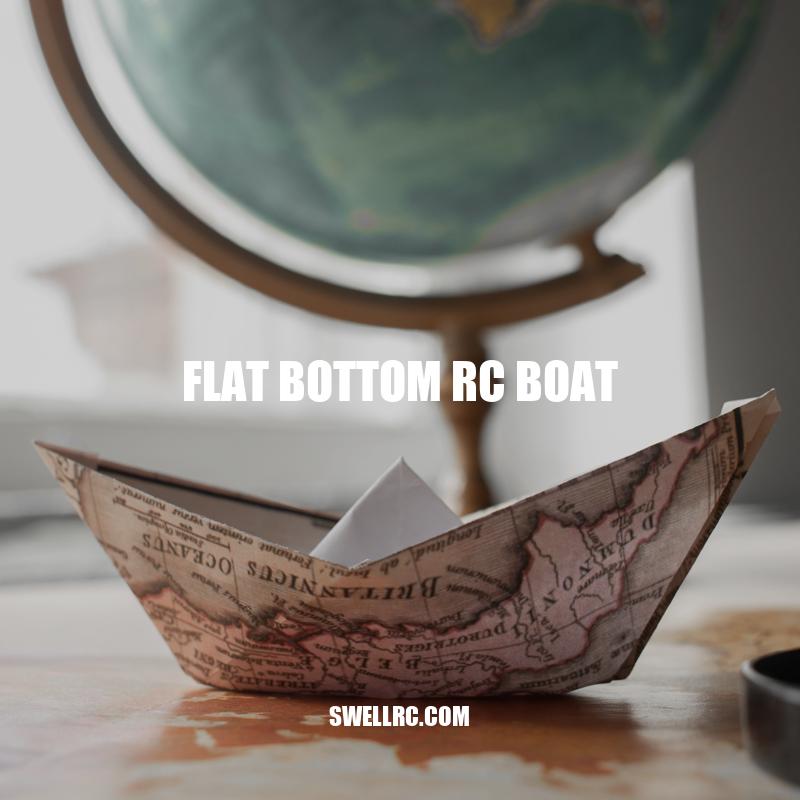Mastering Flat Bottom RC Boats: Design, Materials, Motors, and Safety
Flat Bottom RC boats have gained popularity in recent years among hobbyists and professionals alike. These remote-controlled boats are designed and constructed with a flat bottom and high-speed capabilities that make them a unique addition to the world of RC boating. The low draft of flat bottom RC boats allows them to glide smoothly over shallow water and handle various water surface conditions with ease. While there are numerous types of RC boats available, flat bottom RC boats offer distinct advantages and features. In this article, we will explore the design features, materials used, motor selection, maintenance and care, safety and regulations, and more. Whether you are a seasoned RC boat enthusiast or a newcomer to the hobby, flat bottom RC boats offer an exciting and thrilling boating experience that is worth considering. So, let’s dive into the world of flat bottom RC boats and everything you need to know to own and operate one.
Design Features
Flat bottom RC boats are designed to provide maximum speed and agility while gliding over the water. Here are some of the key design features that make flat bottom RC boats unique:
- Flat bottom: The flat bottom design of these boats allows them to move faster over the water compared to traditional RC boats that have a V-shaped hull. The flat bottom also provides better stability and maneuverability.
- Low draft: The low draft of flat bottom RC boats allows them to operate in shallow water, making them ideal for use on smaller bodies of water like ponds and lakes.
- High-performance hull: The hull of a flat bottom RC boat is specially designed to minimize drag and allow the boat to reach high speeds with ease.
- Planing surface: The planing surface of flat bottom RC boats helps the boat achieve lift and remain on top of the water. This design feature contributes to the boats’ speed and performance on different types of water surfaces.
- Flexibility: The flat bottom design of RC boats allows them to adapt to different water conditions and speeds, giving the operator more control over the boat’s performance.
When selecting a flat bottom RC boat, it is essential to consider the design features and construction materials to ensure optimal performance on the water. Several websites offer a wide range of flat bottom RC boats, each with unique features and specifications to cater to individual preferences and budget. Some of the most popular websites for purchasing a flat bottom RC boat include Tower Hobbies, Horizon Hobby, and Amazon.
What are the advantages of a flat bottomed hull?
A flat bottomed hull offers several advantages over other types of hull designs, particularly in shallow waters, calm conditions, and slow speeds. Here are some of the benefits of a flat bottomed hull:
| Advantages of a flat bottomed hull |
|---|
| Stability: Flat bottomed hulls have a low center of gravity, which provides more stability than other hull types. |
| Shallow draft: Flat bottomed hulls require less water depth, making them ideal for use in shallow or narrow waterways. |
| Increased speed: Flat bottomed hulls have less drag than other hull types, which allows them to achieve higher speeds more easily. |
| Less expensive: Flat bottomed hulls require less material to construct than more complex hull types, making them more cost-effective. |
If you are in need of an example of a well-designed flat bottomed hull, you can check out the Pelican Intruder 12 Jon Boat which is tailor-made for fishing with its wide and stable design.
Materials
Flat bottom RC boats are typically constructed using a variety of materials, each with its own unique characteristics that affect the boat’s performance and handling. Some of the most common materials used in flat bottom RC boat construction include:
- ABS plastic: ABS plastic is a lightweight and durable material commonly used in entry-level models. It is resistant to shock, making it ideal for boats used in rough waters.
- Fiberglass: Fiberglass is a popular material for RC boats because it is strong, lightweight, and provides excellent aerodynamics. Boats made with fiberglass are durable and can withstand high speeds, making them ideal for racing.
- Carbon fiber: Carbon fiber is a lightweight, high-strength material commonly used in high-end RC boats. Boats made with carbon fiber are strong and rigid, offering exceptional speed and control on the water.
The material used in the construction of a flat bottom RC boat plays a vital role in its overall performance and durability. When selecting a boat, consider the body’s weight and strength, along with the material’s durability. In addition to the material, other factors to consider when selecting a flat bottom RC boat include the motor and battery, speed control capabilities, and radio frequencies.
Pros and Cons of Common Materials
Here’s a table summarizing the pros and cons of each of the common materials used in flat bottom RC boat construction:
| Material | Pros | Cons |
|---|---|---|
| ABS plastic | Lightweight, durable, shock-resistant | Not as rigid as other materials, may not provide optimal speed |
| Fiberglass | Strong, lightweight, excellent aerodynamics | May be more expensive, not as rigid as carbon fiber |
| Carbon fiber | Lightweight, high strength, exceptional speed and control | More expensive, can be brittle if not handled with care |
Several websites offer a variety of flat bottom RC boats made with different materials. HobbyKing and Motion RC are some popular websites that offer a wide range of flat bottom RC boats made with different materials to cater to different preferences and budgets.
When selecting a flat bottom RC boat, choosing the right motor is crucial to its overall performance and speed. Here are some common motor types used in flat bottom RC boats:
- Electric motors: Electric motors are often preferred by beginners as they are easy to operate and maintain. They are also environmentally friendly, quiet, and do not require complicated fueling. Electric motors come in brush and brushless varieties with brushless motors being more efficient and powerful but also more expensive.
- Nitro engines: Nitro engines are powered by a fuel mixture of nitromethane, methanol, and oil. They provide high power and speed, making them a popular choice for racing. However, nitro engines require more maintenance and can be loud.
- Gasoline engines: Gasoline engines are similar to nitro engines but use gasoline instead of a nitro mixture. They are powerful, produce a lot of noise, and require frequent maintenance.
The motor selected for a flat bottom RC boat should be based on an individual’s preferences and intended use of the boat. For instance, beginners may prefer electric motors to experience RC boating without excessive hassle. By contrast, experienced boaters that enjoy high speeds may opt for nitro engines.
Motor Comparison Table
Here’s a table comparing the features of each motor type used in flat bottom RC boats:
| Motor Type | Pros | Cons |
|---|---|---|
| Electric | Easy to operate and maintain, environmentally friendly, quiet | Brushless motors may be more expensive, less power compared to nitro and gasoline engines |
| Nitro | Powerful, provides high speed, ideal for racing | Loud, requires more maintenance than electric motors |
| Gasoline | Highly powerful, faster than most nitro engines | Noisy, requires frequent maintenance, not as environmentally friendly as electric motors |
Several websites offer a variety of flat bottom RC boats with different motors. Horizon Hobby and Tower Hobbies are some popular websites that carry a selection of flat bottom RC boats with different motors to cater to different preferences and budgets.
Maintenance and Care
Proper maintenance and care are essential for flat bottom RC boats to function properly and last longer. Here are some tips to keep in mind:
- Clean the boat properly after each use by removing any debris or dirt that might have accumulated on the hull and motor.
- Check for leaks regularly by filling the hull with water and observing whether any water is being discharged from the boat. If water is leaking, you need to get it fixed before it worsens.
- Store the boat in a cool and dry space away from sunlight or moisture. Doing so will protect the boat’s parts from rust or corrosion and make it last longer.
- If applicable, lubricate the motor’s moving parts and the driveshaft with appropriate oil to prevent wear and tear.
- Inspect the battery and other electrical components for any defects or signs of wear and tear and replace them if necessary.
Following these tips will help you keep your flat bottom RC boat in good condition and avoid costly repairs or replacement. Remember, proper maintenance goes a long way in ensuring maximum performance and longevity for your boat.
Recommended Flat Bottom RC Boats Maintenance Products
Here are some products that can help you maintain your flat bottom RC boat optimally:
Waterproof grease: Use to lubricate moving parts of the motor and driveshaft to reduce wear and tear.
Waterproof tape: Use to seal any leaks in the hull quickly and temporarily before taking it to a repairs provider.
Silicone spray: Use on rubber parts and seals to prevent them from drying out and cracking.
You can find these maintenance products and more at popular online retailers such as Amazon or directly from RC boat stores such as Pro Boat.
Safety and Regulations
Operating an RC boat comes with risks that you need to be aware of. Safety guidelines exist to ensure the safety of the operator and the public. Here are some safety tips to consider:
- Always wear a personal flotation device (PFD) when operating your flat bottom RC boat.
- Never operate your boat if its battery is not fully charged or if the motor is not running correctly.
- Do not operate your boat in areas with a high density of people, boats or wildlife.
- Always make sure an adult is supervising you when operating an RC boat if you are a minor.
- Obey all state, federal and local regulations regarding the safe operation of an RC boat.
Regulations vary depending on your state or region, so it is important to check with the relevant authorities. For example, in the US, the U.S. Coast Guard sets out regulations for flat bottom RC boating that vary depending on the size of the boat.
It is also important to note that some flat bottom RC boats may require registration with the relevant authorities before you can operate them on open water. Check with your local authorities for more information.
Where to Find Safety Guidelines and Regulations
You can find more information on the safety guidelines and regulations for flat bottom RC boats on the following websites:
- US Coast Guard Boating Safety – Provides safety guidelines and regulations for boating in the US
- Model Boats Magazine – Provides safety guidelines and regulations for RC boating
- US Coast Guard Navigation Centre – Provides regulations on navigation for boating in US waters
Always remember, adhering to safety guidelines and regulations is not just smart but crucial for a safe and enjoyable RC boating experience.
How does RC boat work?
A Remote Control (RC) boat works by receiving commands from a transmitter which sends radio signals to a receiver on the boat, controlling its speed, direction, and steering. The basic components of an RC boat include the transmitter, receiver, motor(s), servo(s), propeller(s), and battery. Some RC boats may also include additional features like lights, sound effects, and cameras.
If you’re interested in learning more about RC boats, there are numerous websites available with information about how they work, their types, and how to choose and maintain them. You may also find helpful products such as RC boats and their accessories on marketplaces like Amazon or hobbyist stores like Tower Hobbies.
Conclusion
Flat bottom RC boats are a fantastic way to experience the thrill of racing on the water without breaking the bank or having to worry about the expenses associated with a full-scale race boat. They are perfect for both beginners and experienced enthusiasts alike, providing a fun and exciting way to spend your time on the water.
We have covered the unique design and construction of flat bottom RC boats, how to choose the right materials and motor for your boat, and the importance of proper maintenance and care. We also discussed the essential safety guidelines and regulations that you should follow when operating an RC boat.
By following these tips and guidelines, you can enjoy the excitement of RC boating without putting yourself or others at risk. Whether you are an experienced hobbyist or just getting started, a flat bottom RC boat is a great investment that provides endless hours of entertainment and fun.
So, what are you waiting for? Head on over to your local RC store or check online to purchase the perfect flat bottom RC boat for you. Get out on the water and experience the thrill of RC boating today!



